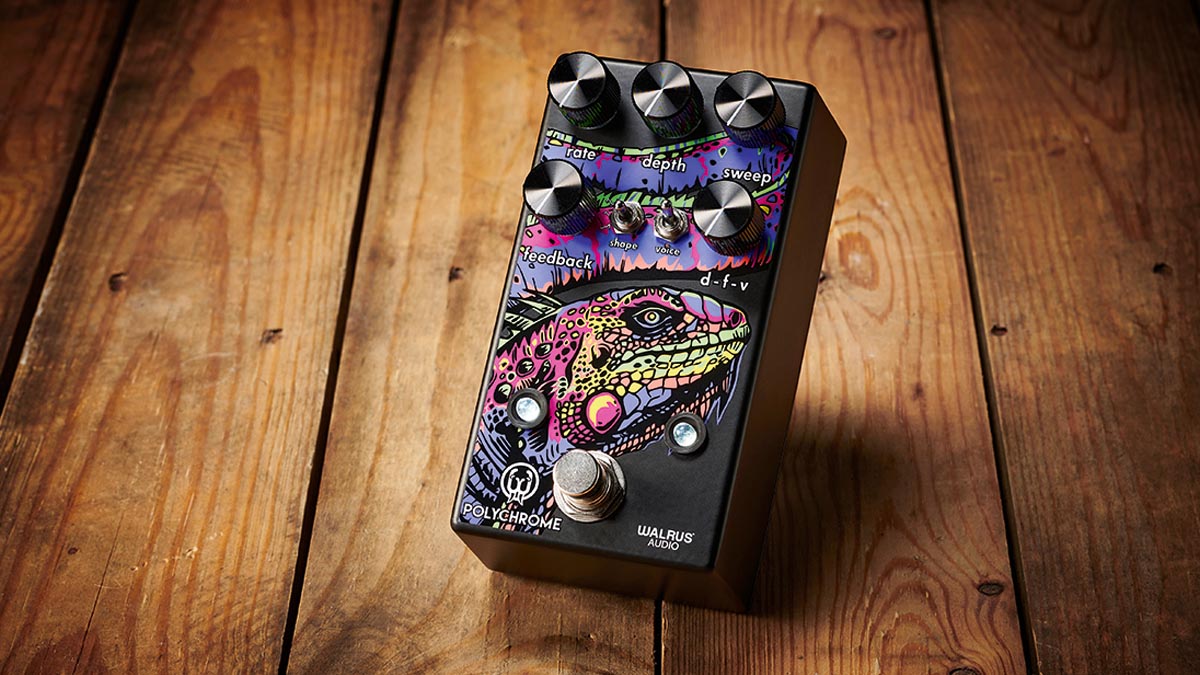Guitar World Verdict
If it's flanging you want, then the Polychrome is a class act: a veritable treasure trove of flanger sounds that will slot nicely onto your ’board.
Pros
- +
Momentary operation.
- +
Wide range of sounds.
- +
D-F-V knob to blend in your effect.
Cons
- -
No expression pedal input.
- -
Slight perceived volume loss on some settings.
You can trust Guitar World
Walrus Audio has several modulation pedals in its roster, notably the Julia chorus and Lillian phaser, which both share similarities with the Polychrome, the brand’s new analog flanger.
In particular, all three pedals sport a Blend knob that moves from totally dry sound to 100 per cent wet. In this case, it’s labelled D-F-V (Dry, Flange, Vibrato) with the most traditional flanger tones at the 50/50 mix, 12 o’clock position, lots of subtler shadings to the left and true vibrato fully clockwise.
In Use

The overall tone of this pedal is warm and mellow, and its forte is quite a range of classy flanging and beyond. Before you even start messing with the knobs, there are six different options available from combinations of the two-way Voice and the three-way Shape switches.
The Voice switch’s lower position offers traditional full-frequency flanging, while Walrus says the other option delivers a more complex and notched flange effect. It can be quite a subtle difference with certain knob settings, but the main thrust of it is the upper position has a notably leaner sound with less bottom-end. The Shape switch selects which shape of LFO wave you want to use to modulate the delay line.
There are traditional sine and triangle choices offering some familiar flanging tones, but you also get a Random option delivering a more unpredictable effect for the adventurous as it varies the modulation in a less regimented fashion.

Rate does exactly the same as with any other modulation pedal and has a range from 0.1Hz to 8Hz, which effectively means it goes from flanging cycles that unfold over several seconds, up to a sweet warble like a Leslie speaker on fast speed.
The Depth knob here, in control of the width of the filter sweep, interacts with the Sweep knob, which shifts the frequency range of that sweep with plenty of nuanced changes available through their combination. This Sweep knob is at its most effective at lower-depth settings; in fact, with the Depth at minimum you can set a frequency and operate the pedal like a static filter.
All the latest guitar news, interviews, lessons, reviews, deals and more, direct to your inbox!
If you want a more intense effect, you can reach for the Feedback knob, which feeds effected sound back through the circuit and can emphasise the sweep’s swoosh and add a metallic sheen. Note, though, that it doesn’t get quite as extreme as the metallic ice-picky flanging that you can coax from a vintage Electric Mistress.
Sounds
There’s something about plugging into a flanger pedal that makes us inevitably want to start playing Message In A Bottle, as well as get into classic rock territory, such as Van Halen’s Unchained and Queen’s Keep Yourself Alive.
The pedal works really well with distortion in front of it for rich textured sound with a sense of movement about it. Traditional flanging aside, though, this is a fine source of varied modulation that include chorus-like tones, pitch vibrato and the aforementioned rotary speaker sounds. That D-F-V knob is your key to just how much effect you want.
With total wet sound, there’s some cool vibrato, but roll it back a bit and you’ll find a whole range of hybrid modulation sounds to be explored. By the same token, there’s plenty of mileage with the knob just a little north of totally dry, with just enough of a tonal shift to pique the interest without overwhelming your core sound.
There’s no expression pedal control available here, but what is really cool is the smart footswitch that, besides its standard latching action, offers momentary activation of the effect with a press and hold – just step on it for flanged emphasis of selected notes, chords or passages.
Specs
- PRICE: $199 / £179
- ORIGIN: USA
- TYPE: Flanger pedal
- FEATURES: True bypass
- CONTROLS: Rate, Depth, Sweep, Feedback, D-F-V blend, Shape switch, Voice Switch bypass footswitch
- CONNECTIONS: Standard input, standard output
- POWER: 9V adaptor, 30mA minimum (Not supplied)
- DIMENSIONS: 70 (w) x 121 (d) x 55mm (h)
- CONTACT: Walrus Audio
Trevor Curwen has played guitar for several decades – he's also mimed it on the UK's Top of the Pops. Much of his working life, though, has been spent behind the mixing desk, during which time he has built up a solid collection of the guitars, amps and pedals needed to cover just about any studio session. He writes pedal reviews for Guitarist and has contributed to Total Guitar, MusicRadar and Future Music among others.


